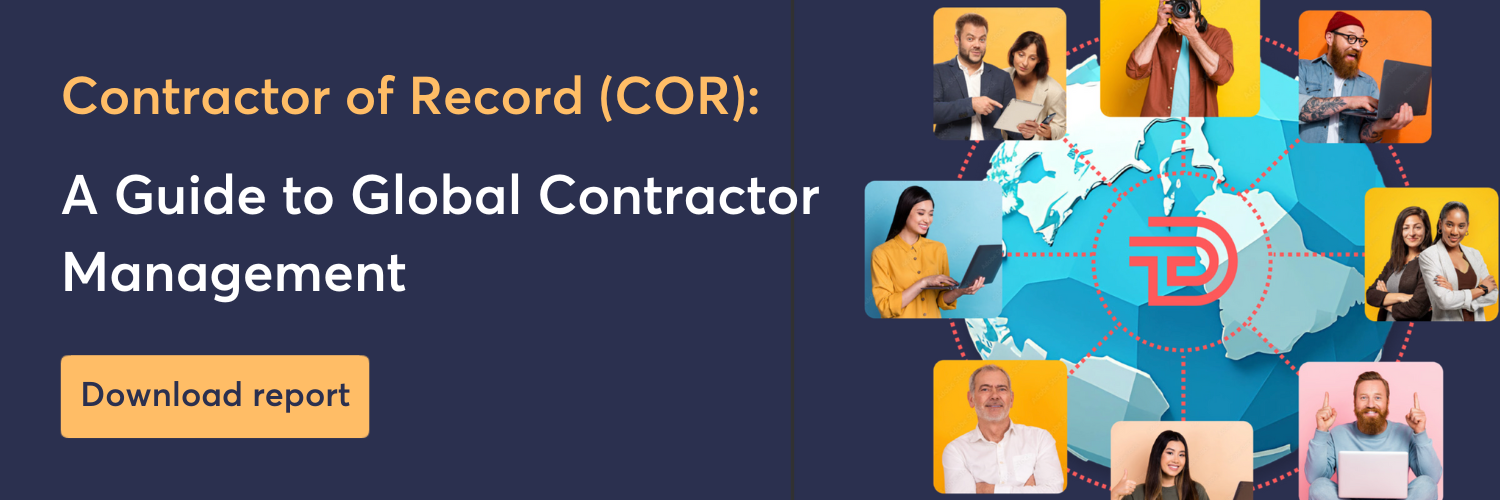What is Vendor Management and how does it help?
- 23 May 2025
- 12 mins read
- Posted in
Updated: 22nd of October 2025
Content
- What is Vendor Management?
- Why Effective Vendor Strategy Matters
- The Vendor Management Lifecycle: Step-by-Step Process
- Benefits of Good Vendor Management
- Common Vendor Management Challenges
- Building a Winning Vendor Management Strategy
- Compliance and Ethical Considerations in Vendor Management
- Conclusion: Why Good Vendor Management is a Strategic Advantage
What is Vendor Management?
Vendor management involves coordinating multiple departments such as legal, tech, HR, and finance to select, onboard, and oversee third-party partners, ensuring they align with business goals and compliance requirements. Additionally, you’ll also require other professionals to ensure smooth business functioning. Think operations managers, cafeteria staff, cleaners, raw material suppliers, transport and logistic professionals. The list is endless.
This is true of any company. Depending on the core business, one particular department may be more expansive – it is expected that a tech company will have more IT professionals in the team. However, all the other skills are crucial in the running of the company too. Given the extensive variety of professionals required, many companies outsource some of these tasks to external vendors.
Vendors are the non-permanent staff who have been hired on a contractual basis to fulfill certain functions. Engaging these vendors brings massive advantages to your company – you get to access specialized skills while keeping your workforce lean. In fact, today, over 40% of your company’s work is delivered by non-permanent staff — vendors, contractors, and freelancers!
The organizational processes you have in place to deal with these professionals is exactly what ‘Vendor Management’ is. When people talk about vendor relationship management, many immediately think of the tools and systems that are used to manage vendor data and information. But there’s more the vendor management lifecycle than just getting the work done from vendors and paying them. Effective vendor management should also include long-term vendor relationship management – which involves the human and operational side of managing all these suppliers. As you may imagine, this calls for a more intricate and nuanced strategy to avoid challenges in vendor management. Let’s see why holistic vendor management is so important and how to build a vendor strategy for yourself.
Why Effective Vendor Strategy Matters
Securing reliable service delivery
When you have diverse vendors, all working to contribute to your company's success, you’ll need a formal process to ensure their efforts are properly streamlined during vendor relationship management. You want them to be working independently – but not in silos!
Think of a situation where you have one vendor team carrying out market research, another delivering raw materials, a third team managing production processes, and a fourth team taking it from there to activate sales efforts. A delay at any one step may impact your entire business output. In the real world, many more teams and processes would be involved – increasing the complexities.
Efficient vendor management helps you understand, and therefore communicate, what exactly you need vendors to deliver, by when and what standards they need to maintain. The better you manage your vendors, the more uninterrupted your service delivery is.
Achieving cost savings through strong partnerships
It is no secret that vendors can bring immense cost savings. Being able to outsource certain functions to an expert team of external vendors can drive immense value for your company – all while keeping your team lean and your overheads low.
But cheap labor or products shouldn’t be the only thing you look for in a good vendor. The better approach is to take a more strategic look at what each vendor offers and select the ones who bring you the most value for your money. Here again, an effective vendor management process makes it easier for you to identify your needs and conduct a cost benefit analysis – rather than just making the decision based on price. (Read more: Vendor selection best practices)
Enhancing business agility and resilience through supplier networks
In today’s competitive business landscape, how quickly you rise to meet market needs has a direct impact on your success as a company. A strong network of vendors and suppliers enables you to do this with ease and speed – thus making you more agile. Taking on a big digital marketing project for a client becomes easier if you already have marketing vendors in your network to step in at a moment’s notice.
It also lets you build resilience into your company strategy. Your vendor ecosystem lets you handle busy and lean periods easily, without the substantial cost and operational challenges associated with hiring or downsizing.
Supporting innovation through strategic vendor collaboration
With a rich network of vendors on board, you have access to a vast variety of skills and thought processes – which is almost impossible to find in a single homogenous team. This kind of diversity encourages innovation. Bring together groups of relevant vendors for a project and empower them to play to their strengths and see the magic unfold through experimentation and ideation!
Additionally, your vendor ecosystem also gives you the confidence to try newer, more innovative solutions yourself, without having to worry about how to execute these ideas.
The Vendor Management Lifecycle: Step-by-Step Process
Step 1: Vendor Sourcing and Selection
Putting in the effort to choose the right vendor at the outset really makes all the difference. Price will play a role in making this decision – after all, project budgets are a reality that you cannot ignore! But this alone should not be the determining factor. Evaluate vendors based on their expertise, capability and experience. Pay attention to factors like how they manage compliance, how they handle data security, what kind of tech systems they use and more.
Going beyond these practical matters, also consider human factors like how well the vendors fit in with your company culture and value system. If you are a sustainability-focussed organization, a vendor that operates on energy intensive processes will obviously not be a great partner.
The key is to find the sweet spot – with vendors that are capable, efficient and aligned to your company ethos – and comes to you at the best price (which may not be the lowest).
Step 2: Contracting and Relationship Setup
Signing the right contracts is an important part of formalizing the vendor relationship. This step is where you negotiate the best terms that work for both you and your vendors.
Once the terms have been agreed upon, put them in writing through Service Level Agreements (SLAs) that outline what exactly will be provided, the timelines and the costs. This defines clear expectations and responsibilities and reduces friction later.
This is also when you should pay attention to onboarding protocols – which include ensuring that the right paperwork and NDAs have been signed, the right documents have been gathered and that you have the vendors’ payment details on file. Checking all these boxes means the work can begin compliantly.
Don’t forget the human side of starting a new relationship! Set up kick-off meetings, make all the necessary introductions and ensure your internal stakeholders know what exactly the vendor will do. Your vendors on the other end, will need to be made aware of who their point of contact will be, what internal processes they must keep in mind and so on. (Read more: Contract management in vendor relationships)
Step 3: Performance Management and Collaboration
All your vendor KPIs and expectations should already be set at the contract stage – but these should be monitored on an ongoing basis. Track whether your vendors are delivering the results that have been mutually agreed upon. Keep an eye on how timely and responsive they are. Monitor whether they are managing compliance as needed.
You can facilitate smooth functioning by keeping communication channels open, offering timely feedback and highlighting areas of improvement. Don’t forget to give credit where it’s due and celebrate great performance!
This step is not to micromanage or add in cumbersome checkpoints. The idea is to create a truly collaborative environment where great work is done and everyone is driven by a spirit of continuous improvement. A Vendor Management System (VMS) is ideal for achieving this.
Step 4: Risk and Compliance Management
Identifying potential vendor risks is a crucial part of ensuring business continuity. If some of your vendors are more prone to being impacted by weather fluctuations, political unrest or labor issues, then any disruptions at their end can hamper your business output. Similarly, a security breach by a vendor may compromise your proprietary company information.
Work with the relevant legal and contract teams to identify these risks and build a proactive mitigation strategy. For example, having diverse vendors supplying raw materials ensures business continuity – even if one of them doesn’t deliver due to weather or other factors, your operations don’t come to a screeching halt.
An important part of vendor risk management is to identify where their failures may open your company up to potential lawsuits. If a vendor fails to manage data, ESG or labor law compliance, ascertain how it will impact you. Here again, your legal teams can help you protect yourself against these risks. Want to learn more about remaining compliant when using vendors and contractors? ⬇️
Step 5: Renewal, Offboarding, and Continuous Improvement
A vendor relationship reaches its conclusion when the contract ends. Here, you can either renew their contract – or offboard them if you feel they haven’t measured up.
You will need to have established criteria for identifying underperforming vendors. This includes a formal, objective process that tracks their performance against the agreed upon KPIs. If you decide to end the engagement, move on to the offboarding process. This involves revoking their access to company data, ensuring they have turned in any equipment they may have had access to, and closing the loop by making sure that all outstanding payments have been cleared.
In an ideal scenario, each vendor partnership will continue over the long term. Even in these cases, always ensure that contracts are renewed and all paperwork is updated in a timely manner.
Benefits of Good Vendor Management
- Cost-efficiency through relationship optimization
Cost efficiency is one of the most tangible benefits of vendor management. A supplier you have a great rapport with may be willing to give you fixed pricing that keeps your expenditures stable even through market fluctuations. Likewise, you may be able to get better negotiation leverage. Entering a retainer agreement can give you access to better rates – while the vendor gets a guarantee of steady work.
Another way a long-term vendor may be able to offer cost efficiencies is by helping you consolidate your supply chains. If they understand your business plans for the future, they may be able to adapt their own practices to align better with your needs.
- Risk reduction and compliance assurance
The longer you work with a supplier, the more familiar you are with how they handle compliance. You then have a greater assurance in their processes – not to mention greater trust that they will do their best to keep you protected against risks or losses.
While you should still continue regular monitoring and reviews, these long-term relationships bring you more peace of mind, knowing that these vendors will not put you at unnecessary risk or exposure.
- Faster issue resolution through transparent communication
It is in a vendor's best interest to protect their long-term relationships too, and ensure quick resolution of issues for clients they know and trust. This is why any good vendor will welcome open and transparent communication.
At your end, you might be more comfortable communicating with these vendors and expressing your needs and requirements freely. These vendors may also work with you collaboratively to come up with creative solutions to new challenges.
Common Vendor Management Challenges
- Over-reliance on manual processes
One of the most common challenges of vendor management is caused by over-reliance on paper-based systems. Not only are they more time-consuming and effort-intensive, they are also more prone to human error.
Such inaccuracies only add to the confusion and frustration during audits. What’s more, they also hamper your ability to make data-driven decisions. For instance, without accurate data, you may think you are spending a lot less than you really are – and get an unwelcome surprise when you overshoot your project budget!
But even if all your paper records are accurate, it still limits your visibility as an organization. If you have a large supplier base or multiple locations across geographies, you can not know how vendors are being managed at your other locations if paper records are all you have to go by.
- Lack of clear ownership or accountability
This arises when a company does not have a formalized vendor management process. Your internal stakeholders may not know exactly who is managing what. As a result, you may experience gaps like delayed deliveries, missed payments or forgotten contract renewals.
Establish ownership by creating a dedicated vendor management team who is responsible for the end-to-end process – from onboarding to offboarding or renewals. Not only will your vendor engagements become a lot smoother, your suppliers will be more satisfied and fulfilled too, leading to more long-term engagements.
- Poor communication leading to misunderstandings
When vendor management is handled on an ad hoc basis, it leaves room for a lot of miscommunication. You have individual managers giving different directions to vendors, with no formal understanding of what they are actually supposed to deliver.
This leaves a lot of room for ambiguity, causing friction and resentment for both parties. No vendor is happy with scope creep if it greatly exceeds what they originally agreed to do. Similarly, you as a client organization, may have to deal with less-than-desirable results if these outputs are not clearly defined through proper Service Level Agreements (SLAs) and Scope of Work (SOWs) at the start of the project.
- Inconsistent risk assessment and due diligence
Even if you have been working with a vendor for a long time, ongoing risk and compliance assessments are critical. Your vendors’ compliance responsibilities may change due to evolving laws around work.
Some of the cyber risks that we face today did not even exist five years back. So the way they manage data and information would need to be updated too. Without ongoing monitoring processes, this is something you may very easily miss checking up on. Likewise, if a vendor contract is not renewed on time, continuing to send them company data may put you at risk of non-compliance.
Building a Winning Vendor Management Strategy
Aligning Vendor Goals with Business Objectives
Win-win situations create the best vendor relationships. So, when choosing your vendors, communicate your business objectives and see if it aligns with their goals too.
For instance, a vendor who may be looking to grow their presence in your region, may give you better rates for a chance to get a foothold in the geography. Similarly, if you are looking to expand in a particular functional domain, talk to your vendors and see if they’d be willing to adapt their service expertise to cater to you better.
Every vendor engagement is an opportunity to co-create value for each other – laying the foundation for a healthy strategic partnership rather than a purely transactional one.
Classifying Vendors: Strategic vs. Tactical Suppliers
This begins with having a comprehensive vendor database so you have full visibility of all the suppliers you are working with. Once you have this bird’s-eye view, it’s easier to classify them based on the roles they fulfill. Ascertain who are your strategic vendors who offer business-critical services, and who are fulfilling more tactical roles.
Have a vendor risk management plan in place for each category of suppliers. You may find that you are over-reliant on one vendor who fulfills a function that’s very critical for your business. Here, it may be a good idea to diversify and find more vendors who can fulfil that function – just in case that primary vendor is unable to deliver in a particular situation.
Effective Communication and Feedback Mechanisms
It’s also important to set up open channels for ongoing communication. This enables you to send information, direction or organizational updates to your vendors, while they can send you updates, flag potential issues or communicate delays in a timely manner.
Don’t forget to set up recurring feedback and review cycles to discuss what went right, what went wrong and what can be improved upon. Equally importantly, it lets you show appreciation and share positive feedback with your vendors!
And this feedback goes both ways. Your external vendors can give you valuable insights about your company from a third-party perspective – pointing out various gaps, challenges or suggestions that your internal team may not have thought of.
Risk Mitigation Planning and Escalation Paths
Your vendors are required to maintain regulatory compliance around ESG, finance, cybersecurity and more. Risks in all these areas are always evolving, so they should have the capability to react fast and adapt to changing needs. A supplier who uses legacy systems and outdated processes is more likely to fall behind on compliance requirements and expose you to risks.
This is why it’s important to evaluate your vendors on an ongoing basis and get a critical view of how well they are managing compliance. Stay on top of this by having a protocol that requires them to update all relevant documents and paperwork every year. If you notice gaps or potential areas of risk, be sure to flag these to your vendors right away so they may rectify the problem. Have a time-bound window by which they need to fix any compliance issues.
Do also have a backup strategy in case some of your existing vendors are not able to rectify issues on time. In these situations, you may need to switch vendors so as not to interrupt your operations.
Compliance and Ethical Considerations in Vendor Management
- Regulatory requirements
We have talked about how your vendors need to uphold regulatory vendor compliance and risk management. But what exactly does this involve? This includes everything that proves how safely, effectively and legally your vendors are able to do their jobs. It covers:
Industry credentials: You’d want them to have updated licenses and certifications that show they are qualified to perform as per the most recent industry standards.
Quality control compliance: You would need them to meet certain quality standards for the products they deliver. This is particularly important for vendors in healthcare, construction, and other fields where the health and safety of your clients, consumers or employees may be at risk.
Data protection: You’d want your vendors to manage your data and that of your consumers safely and securely as per the laws in your geography.
Legal compliance: You’d need your vendors to be operating legally and ethically so as not to compromise your company values.
- Confidentiality, IP, and ethical sourcing considerations
This includes strict protocols around how the vendor will handle confidential data. They may have access to new products that your company plans on launching, IP-protected designs and artwork, and proprietary research – and you need to know that these will not be leaked in the market. Formalize all protocols around this through NDAs and confidentiality clauses that you update regularly, and get these signed by your vendors
Another consideration is around ethical protocols. As a value-driven organization, you would want to be associated with vendors who operate with integrity. This includes everything from how they source their raw materials, what kind of labor practices they follow and how considerate they are about their ecological footprint. Setting clear expectations around these parameters ensures that your vendors understand exactly what standards they are required to maintain – thus upholding the integrity across your entire supply chain.
- Vendor diversity, equity, and inclusion (DEI)
Given that freelancers, contractors and external vendors make up such a large part of organizations’ workforce, many companies today are extending their DEI policies beyond just their employees.
This means adding more diverse-owned companies in your supplier and vendor portfolio – and making your proposal process more inclusive so that these businesses can pitch to work with you in the first place. It also means choosing to work with vendors who are as committed to DEI practices as you are. Done right, this would make your hybrid workforce richer and more diverse than ever before.
Conclusion: Why Good Vendor Management is a Strategic Advantage
A diverse ecosystem of vendors offers undeniable advantages. They enable you to respond more quickly to the evolving needs of your industry and leverage the expertise of top professionals in the field – all while maintaining a lean team yourself. The benefits if vendor management are massive, as are the operational conveniences.
But as with any part of your workforce, there’s a right way and a wrong way to manage your vendors. Just onboarding the cheapest suppliers and managing them through ad-hoc processes is not the way to go! At best, this will mean your engagement remains purely transactional. With luck, you may not face any major issues, but you won’t be able to enjoy the full spectrum of advantages your vendors can help you unlock either. In worst case scenarios however, these kinds of vendor engagements can spiral into cost inefficiencies, poor quality of work and graver compliance issues.
The great news? The right way to go about it is not that difficult! It involves having a smart vendor management process specifically designed to drive operational success. It brings together both the tools and technologies required to manage your vendors as well as the human intelligence it requires to nurture these relationships into thriving, long-term partnerships.
At TalentDesk, we bring you the best of both worlds. Our 15 years of experience in the talent landscape gives you easy access to our compliance support, our regulatory know-how and our knowledge of vendor management. Of course, we supplement all this human intelligence with state-of-the-art vendor management platform support as well, which has been designed to ease and automate a lot of the complexities we have discussed above. This empowers you to manage vendors, compliance, performance and relationships – all in one fell swoop!

Sanhita Mukherjee
Frequently asked questions
What are the key stages of the vendor management lifecycle?
The lifecycle includes five key stages: vendor sourcing and selection, contracting and onboarding, performance and relationship management, risk and compliance monitoring, and finally, offboarding or renewal. Each stage helps optimize outcomes and mitigate risks throughout your vendor partnerships.
How can I build strong relationships with my vendors?
Trust and transparency are essential. Define expectations early, use SLAs and regular feedback loops, and treat vendors as strategic partners rather than just service providers. This encourages innovation and long-term collaboration.
Why is vendor classification important for business continuity?
Not all vendors have the same impact on your operations. Classifying them into strategic (critical to business goals) vs. tactical (transactional support) allows you to allocate oversight, plan redundancies, and reduce operational risk effectively.
What’s the most common pitfall in vendor management?
Lack of structure—especially manual tracking via spreadsheets or emails—often leads to compliance gaps, late payments, and poor performance oversight. Adopting centralized tools and assigning ownership drastically improves consistency.
Speak to us to find out how we can help you manage vendors
Related articles

Vendor Onboarding Checklist: Best Practices for Compliance & Integration
Streamline your vendor onboarding process with this comprehensive checklist. Learn best practices for compliance, documentation, and automation.

Vendor Selection Best Practices: How to Choose the Right Supplier
Learn how to choose the right talent vendor. This guide covers best practices for vendor selection, from pricing and capacity to ensuring compliance.

Freelancer Management System (FMS) vs Vendor Management System (VMS)
Discover the differences between freelancers and vendors, when to use FMS or VMS, and how an integrated approach like TalentDesk helps manage both easily.

Contract Management in Vendor Relationships
Learn how to manage vendor contracts effectively, from key clauses and negotiation tips to lifecycle best practices that reduce risk and boost performance.

10 Best Freelancer Management Software (FMS) Tools to Consider in 2025
Explore top 10 Freelancer Management Software tools to consider in 2025. Centralize hiring, streamline onboarding, compliance & simplify global payments

Integrating Accounting Systems with Freelancer Platforms
Read how integrating freelancer platforms with accounting systems transforms your operations. Streamline payments, compliance & gain real-time visibility.
.jpg?width=650&height=167&name=what%20is%20a%20vendor%20management%20system%20(VMS).jpg)
What is a Vendor Management System (VMS)? A Complete Guide
Looking for a VMS? Compare top vendor management systems, explore key features, and learn how automation can streamline your contractor workflows.

Best Contractor Management Software for 2025
Discover the best contractor management software to streamline workflows, ensure compliance, and simplify payments. Manage global contractors with ease.

Mastering Influencer Management: Strategies for Effective Collaboration
Our guide to influencer management, exploring strategies, tools, and tips to create successful influencer relationships and enhance your marketing impact.

10 Reasons Why You Don’t Need a Contractor Management System
Discover 10 hilarious reasons why you absolutely don’t need a contractor management system - because who needs efficiency, happy freelancers, or sleep?

